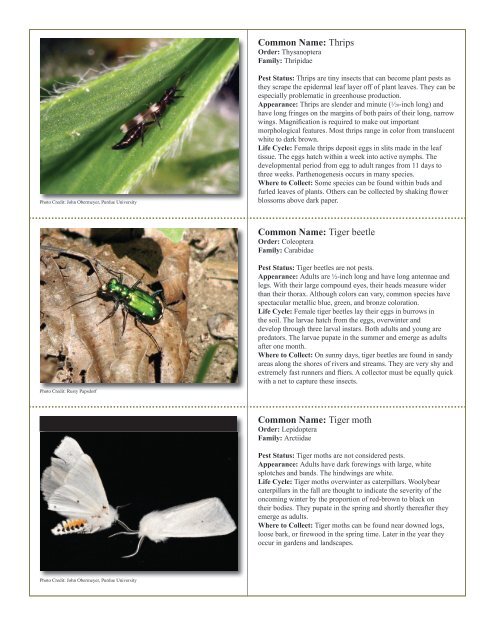to download pdf - Purdue Extension Entomology - Purdue University
to download pdf - Purdue Extension Entomology - Purdue University
to download pdf - Purdue Extension Entomology - Purdue University
You also want an ePaper? Increase the reach of your titles
YUMPU automatically turns print PDFs into web optimized ePapers that Google loves.
Common Name: Thrips<br />
Order: Thysanoptera<br />
Family: Thripidae<br />
Pho<strong>to</strong> Credit: John Obermeyer, <strong>Purdue</strong> <strong>University</strong><br />
Pest Status: Thrips are tiny insects that can become plant pests as<br />
they scrape the epidermal leaf layer off of plant leaves. They can be<br />
especially problematic in greenhouse production.<br />
Appearance: Thrips are slender and minute ( 1 ⁄20-inch long) and<br />
have long fringes on the margins of both pairs of their long, narrow<br />
wings. Magnification is required <strong>to</strong> make out important<br />
morphological features. Most thrips range in color from translucent<br />
white <strong>to</strong> dark brown.<br />
Life Cycle: Female thrips deposit eggs in slits made in the leaf<br />
tissue. The eggs hatch within a week in<strong>to</strong> active nymphs. The<br />
developmental period from egg <strong>to</strong> adult ranges from 11 days <strong>to</strong><br />
three weeks. Parthenogenesis occurs in many species.<br />
Where <strong>to</strong> Collect: Some species can be found within buds and<br />
furled leaves of plants. Others can be collected by shaking flower<br />
blossoms above dark paper.<br />
Common Name: Tiger beetle<br />
Order: Coleoptera<br />
Family: Carabidae<br />
Pho<strong>to</strong> Credit: Rusty Papsdorf<br />
Pest Status: Tiger beetles are not pests.<br />
Appearance: Adults are ½-inch long and have long antennae and<br />
legs. With their large compound eyes, their heads measure wider<br />
than their thorax. Although colors can vary, common species have<br />
spectacular metallic blue, green, and bronze coloration.<br />
Life Cycle: Female tiger beetles lay their eggs in burrows in<br />
the soil. The larvae hatch from the eggs, overwinter and<br />
develop through three larval instars. Both adults and young are<br />
preda<strong>to</strong>rs. The larvae pupate in the summer and emerge as adults<br />
after one month.<br />
Where <strong>to</strong> Collect: On sunny days, tiger beetles are found in sandy<br />
areas along the shores of rivers and streams. They are very shy and<br />
extremely fast runners and fliers. A collec<strong>to</strong>r must be equally quick<br />
with a net <strong>to</strong> capture these insects.<br />
Common Name: Tiger moth<br />
Order: Lepidoptera<br />
Family: Arctiidae<br />
Pest Status: Tiger moths are not considered pests.<br />
Appearance: Adults have dark forewings with large, white<br />
splotches and bands. The hindwings are white.<br />
Life Cycle: Tiger moths overwinter as caterpillars. Woolybear<br />
caterpillars in the fall are thought <strong>to</strong> indicate the severity of the<br />
oncoming winter by the proportion of red-brown <strong>to</strong> black on<br />
their bodies. They pupate in the spring and shortly thereafter they<br />
emerge as adults.<br />
Where <strong>to</strong> Collect: Tiger moths can be found near downed logs,<br />
loose bark, or firewood in the spring time. Later in the year they<br />
occur in gardens and landscapes.<br />
Pho<strong>to</strong> Credit: John Obermeyer, <strong>Purdue</strong> <strong>University</strong>
















